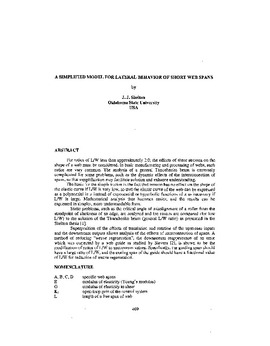| dc.contributor.author | Shelton, J. J. | |
| dc.contributor.other | International Conference on Web Handling (2001) | |
| dc.date.accessioned | 2019-11-08T18:59:09Z | |
| dc.date.available | 2019-11-08T18:59:09Z | |
| dc.date.issued | 2001-06 | |
| dc.identifier | oksd_icwh_2001_shelton | |
| dc.identifier.citation | Shelton, J. J. (2001, June). A simplified model for lateral behavior of short web spans. Paper presented at the Sixth International Conference on Web Handling (IWEB), Stillwater, OK. | |
| dc.identifier.uri | https://hdl.handle.net/11244/321829 | |
| dc.description.abstract | For ratios of L/W less than approximately 2.0, the effects of shear stresses on the shape of a web must be considered. In basic manufacturing and processing of webs, such ratios are very common. The analysis of a general Timoshenko beam is extremely complicated for some problems, such as the dynamic effects of the interconnection of spans, so that simplification may facilitate solution and enhance understanding. | |
| dc.description.abstract | The basis for the simplification is the fact that tension has no effect on the shape of the elastic curve if L/W is very low, so that the elastic curve of the web can be expressed as a polynomial in x instead of exponential or hyperbolic functions of x as necessary if L/W is large. Mathematical analysis thus becomes easier, and the results can be expressed in simpler, more understandable form. | |
| dc.description.abstract | Static problems, such as the critical angle of misalignment of a roller from the standpoint of slackness of an edge, are analyzed and the results are compared (for low L/W) to the solution of the Timoshenko beam (general L/W ratio) as presented in the Shelton thesis [1]. | |
| dc.description.abstract | Superposition of the effects of translation and rotation of the upstream inputs and the downstream outputs allows analysis of the effects of interconnection of spans. A method of reducing "weave regeneration", the downstream reappearance of an error which was corrected by a web guide as studied by Sievers [2], is shown to be the modification of ratios of L/W to uncommon values. Specifically, the guiding span should have a large ratio of L/W, and the exiting span of the guide should have a fractional value of L/W for reduction of weave regeneration. | |
| dc.format | application/pdf | |
| dc.language | en_US | |
| dc.publisher | Oklahoma State University | |
| dc.rights | In the Oklahoma State University Library's institutional repository this paper is made available through the open access principles and the terms of agreement/consent between the author(s) and the publisher. The permission policy on the use, reproduction or distribution of the article falls under fair use for educational, scholarship, and research purposes. Contact Digital Resources and Discovery Services at lib-dls@okstate.edu or 405-744-9161 for further information. | |
| dc.title | Simplified model for lateral behavior of short web spans | |
| osu.filename | oksd_icwh_2001_shelton.pdf | |
| dc.description.department | Mechanical and Aerospace Engineering | |
| dc.type.genre | Conference proceedings | |
| dc.type.material | Text | |
